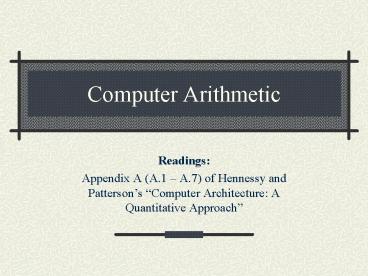Computer Arithmetic - PowerPoint PPT Presentation
1 / 11
Title:
Computer Arithmetic
Description:
A byte is 8 bits. A word is 4 bytes (a doubleword is 8 bytes and a half-word is 2 bytes) ... first 23 bits of product, round up if the discarded bits exceed ' ... – PowerPoint PPT presentation
Number of Views:20
Avg rating:3.0/5.0
Title: Computer Arithmetic
1
Computer Arithmetic
- Readings
- Appendix A (A.1 A.7) of Hennessy and
Pattersons Computer Architecture A
Quantitative Approach
2
Computer Arithmetic
- Number storage (like memory and registers) is
generally accomplished with bits, which are
ON-OFF switches that represent binary digits - A byte is 8 bits
- A word is 4 bytes (a doubleword is 8 bytes and a
half-word is 2 bytes) - The bits represent 1s and 0s in the binary
(base-2) number system
3
Integer Representation
- Unsigned integers are represented as sequences of
bits (e.g. 10010101 149 base 10) - Signed integers reserve the most significant bit
as the sign bit -- if it is 1 it is negative - Three ways to represent negatives
- Sign bit only
- Ones complement (toggle all the bits)
- Twos complement (toggle all the bits and add one
to the number) - We prefer twos complement because it behaves
nicely, especially with respect to zero (ones
complement has two representations of zero, but
not twos complement)
4
Integer Addition/Subtraction
- String together a chain of full adders (one for
each bit in the integers), linking the carry-out
of one adder to the carry-in of the next - For addition, feed a 0 to the first adders
carry-in - In a twos complement system, to compute a-b,
simply add a to the ones complement of b and use
a 1 as the carry-in digit - Note that with twos complement, the result of
addition or subtraction is correct for the stored
bits regardless of the carry-out from the highest
order bit - Overflow occurs when the carry-out is different
from the carry-in to the last adder
5
Integer Multiplication (unsigned)
- Requires extra register P that is initially zero
- Assume operands are in registers A and B
- Repeat the following for each bit
- If the least significant digit of A is 1, then
add B to P otherwise, add 0 to P - Shift A one bit right, discarding the bit that
falls off the end - Shift P one bit right, moving the bit that falls
off the end to the high-order position of A - Product is in P and A, where A has the low-order
bits and P the high-order bits
6
Integer Division (unsigned)
- Again, assume that A and B contain the operands
and P is an extra zero register - Repeat the following for each bit
- Shift P one bit left, discarding anything that
falls off the left end - Shift A one bit left, moving the bit that falls
off the end to the low-order position in P - Subtract B from P
- Set the low-order bit of A to the complement of
the sign bit of P - If P is negative, add B back to P
- Register A has quotient, P has remainder
7
Signed Multiplication?
- A technique called Booth recoding allows precise
treatment of negative multipliers in hardware
see handout for details - Since division is slow anyway, signed division is
implemented by (initially) ignoring the sign bit,
doing an unsigned divide, and then calculating
new sign bit
8
Brief Introduction to Floating Point Arithmetic
- FP standard is IEEE 754
- A single-precision (32-bit) number x is
represented with a sign bit, a 23-bit fractional
part f and an 8-bit biased exponent e such
that x 1.f x 2e-127 - Question Why would anyone want to write a biased
exponent instead of twos complement? - Some numbers do not have exact floating point
representations because of the base-2 exponent - x0.5 f 0 and e 126 (in binary)
- What about x 0.3? 0.9?
9
Special FP Numbers
- Infinity e 255, f 0 (sign bit applies)
- NaN e 255, f gt 0
- Result for things like sqrt(-1), 0/0, 0
infinity - Zero e 0, f 0
- Trick Question If zero is represented in this
way with e0, then what is the representation of
1 in IEEE 754? - Denormal numbers are used to represent very small
quantities (i.e. smaller than 2-127) - A denormal number is indicated by e 0, f gt 0
- Decimal equivalent is 0.f x 2-127
10
FP Multiplication
- Simplest operation
- Use an integer multiply on the fractional parts
to obtain the new fractional part (take the first
23 bits of product, round up if the discarded
bits exceed 1000) - The XOR of the sign bits is the new sign
- Add the biased exponents together and subtract
127 to get the new exponent - Overflow occurs when the exponent addition
overflows however, underflow does not always
occur when the exponent addition underflows (the
result may be a denormalized number) - Some machines use software to trap a denormalized
result rather than complicate hardware
11
Other FP Operations
- See the reading for details if you are interested
I do not expect you to know them in great
detail - Some highlights
- In addition/subtraction, precision is maintained
by shifting the operand with the smaller exponent
to the right until its exponent is the same as
the larger one - Rounding is similar to the case in multiplication
- In division, the general algorithm to calculate
a/b is to calculate 1/b using Newtons method,
and then multiply by a to get a/b































